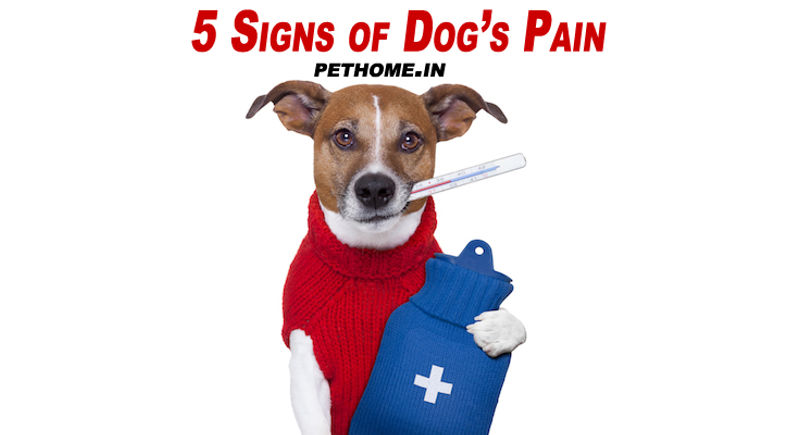
Sometimes we couldn’t notice that our Pet Dog is in Pain as Symptoms are less Noticeable or often Skipped. Seeing our pets in pain is never a good experience, and it’s something every dog owner dreads. Whether it’s a fresh injury or simply our aging elder-pups, we want nothing more than to help them. But it’s important to remember that they can’t always cry out to us when in need. Dogs aren’t humans, so they don’t speak our language. The best thing we can do to keep them comfortable is to learn theirs.
5 Common Symptoms:
1. Inappetence
Lack of appetite is often the result of some sort of discomfort. You don’t feel like eating when you’re not well, do you? Our dogs don’t either. They simply just don’t feel like eating, especially when it’s painful to walk all the way over to the food bowl. If you notice any sort of inappetence in your pet, it’s important to seek veterinary attention right away, as this could be a symptom of many dangerous ailments.
2. General Behavior Changes
You might notice that your pup doesn’t want to walk up stairs anymore, avoids jumping and climbing, or doesn’t want to chase after his beloved tennis ball. There are the obvious signs such as limping, but it’s important to also watch out for stiffness or arched backs. Dogs in pain often lay only flat on their sides, rather than curled up in their beds. They might be slower moving, sleeping a lot more and seemingly disinterested in things they used to love.
3. Excessive Grooming
It’s normal for dogs to lick and groom themselves, but it’s not normal for this to become an obsessive behavior. If you notice your pet tending to a localized area he’s never noticed before, or has just recently started spending a lot more time there, it could be a sign that he’s hurting. Pets will often groom places that are sources of pain in hopes to clean and care for the wound, even if there is no open wound present. Be sure to keep an eye on the area and inspect it gently.
4.Heavy Panting
Panting is normal behavior that shouldn’t surprise any dog owner. Even when the panting is heavy, certain circumstances allow for it such as extra hot days and strenuous exercise. But if you notice heavy panting out of nowhere, it could be stress-induced. This stress could be caused by pain your pet is experiencing. For whatever reason it may be, unexplained heavy panting should result in a trip to your veterinarian.
5.Shyness & Aggression
You may notice that your dog is starting to become more and more antisocial. He may stop running to the door to greet everyone and avoids petting. Or you may notice that your little one doesn’t want you picking her up anymore, or cries when you do. If this happens suddenly, it’s reasonable to suspect pain as a probable cause. In some cases, you’ll find your normally overly friendly companion has become aggressive. If you notice your pup is hiding away and avoiding attention, be sure to check them for pain. It’s best to have a veterinarian do this, and it’s very important to remember not to take it personally if your dog does growl or snap at you. They aren’t necessarily trying to hurt anyone, they just have no other way to tell anybody it hurts and they don’t want to be touched.
Being able to identify early signs of pain can lead to a much more comfortable outcome for both you and your dog. If old age is the culprit, you’ll be more aware and educated on keeping your loved one comfortable and happy through his latter years. By keeping our pets happy, we keep ourselves happy too. And there’s nothing more important than sharing a peaceful, lighthearted life with our best friends.
How to Alleviate the Pain :
Among the most common medications your vet might recommend for your pet's pain are nonsteroidal anti-inflammatory drugs (or NSAIDs), which offer relief similar to your own Ibuprofen or Aleve. PetHome suggests these medications can help reduce pain, swelling, stiffness, and any joint discomfort he may be feeling. Some NSAIDs created specifically for dogs include carprofen, deracoxib, firocoxib, and meloxicam. Many commonly used human approved NSAIDs may be toxic to your dog, however, so don't just use your pain medication–speak to your veterinarian first. The Food and Drug Administration [FDA] has an easy way to remember the signs of worrisome side effects of NSAIDs with the acronym, "BEST":
- Behavioral changes
- Eating less
- Skin redness or scabs
- Tarry stool, diarrhea, or vomiting
Stop using the medication and call your vet immediately if you see any of these issues.
Eliminating it for Betterment
Although pain medications may work as a temporary fix, the ultimate goal is permanent dog pain relief. You may work toward this goal with a change in food. Your dog's pain might be alleviated by changing his food. Products that are high in omega-3s, can help reduce pain by alleviating joint inflammation.
You can also help ease some pain with some careful weight management. Extra pounds can cause painful health issues like pancreatitis and a sliding kneecap to worsen. If your dog needs to lose weight, try a food specially formulated to help your dog shed it in a healthy way, such as Vet Life –Obesity Control or Farmina N&D Light Dog Food.
Another option is physical therapy. This may also help in your dog's comfort when dealing with recovery from injury or with arthritis. Ask your veterinarian about physical therapy treatments.
What Not to Do
You might be tempted to give your dog something from your own medicine cabinet if he's in pain. Not so fast. Although dog-approved NSAIDs are similar to common over-the-counter medications you might buy for yourself, the human variety can be very dangerous to a dog. This is because the dosages needed by dogs may be very different than those of a human, or the metabolism of the drug may be different. Just one pill could exacerbate health issues and even result in death.
Never give pain medication to your pet without first consulting your veterinarian. The veterinarian most familiar with your dog's health concerns should be able to tell you the proper medicine as well as dosage to provide your dog to ensure it accurately treats his pain.
You know your canine companion best. If you feel like something is wrong with him, trust your instinct and remember signs of pain in a dog can be subtle. A call to your vet is always a safe be.
Hope It will Prove Helpful for Ideal Pet Parenting.
Thank you
Vivek Attri
CEO-PetHome
People need to know, please share!
Basic Sources : Vet Journals,Stanford Vet Needs Journal and Research Data.

